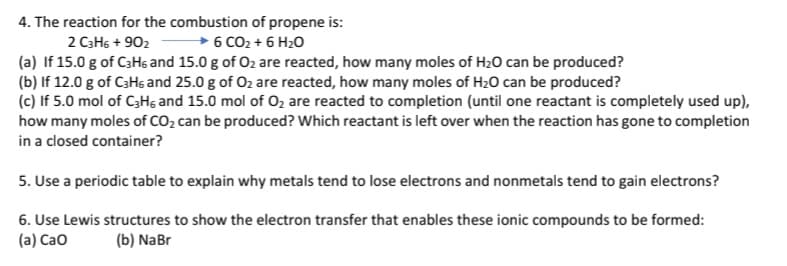4. The reaction for the combustion of propene is: 2 C3H5 + 902 (a) If 15.0 g of CaHs and 15.0 g of O2 are reacted, how many moles of H20 can be produced? (b) If 12.0 g of C3H, and 25.0 g of O2 are reacted, how many moles of H20 can be produced? (c) If 5.0 mol of C3Hs and 15.0 mol of Oz are reacted to completion (until one reactant is completely used up), how many moles of CO2 can be produced? Which reactant is left over when the reaction has gone to completion in a closed container? + 6 CO2 + 6 H20
4. The reaction for the combustion of propene is: 2 C3H5 + 902 (a) If 15.0 g of CaHs and 15.0 g of O2 are reacted, how many moles of H20 can be produced? (b) If 12.0 g of C3H, and 25.0 g of O2 are reacted, how many moles of H20 can be produced? (c) If 5.0 mol of C3Hs and 15.0 mol of Oz are reacted to completion (until one reactant is completely used up), how many moles of CO2 can be produced? Which reactant is left over when the reaction has gone to completion in a closed container? + 6 CO2 + 6 H20
Chemistry: Principles and Reactions
8th Edition
ISBN:9781305079373
Author:William L. Masterton, Cecile N. Hurley
Publisher:William L. Masterton, Cecile N. Hurley
Chapter3: Mass Relations In Chemistry; Stoichiometry
Section: Chapter Questions
Problem 54QAP: Ammonia reacts with a limited amount of oxygen according to the equation...
Related questions
Question
Please answer number 4

Transcribed Image Text:4. The reaction for the combustion of propene is:
2 C3H5 + 902 - 6 CO2 + 6 H20
(a) If 15.0 g of C3H6 and 15.0 g of O2 are reacted, how many moles of H20 can be produced?
(b) If 12.0 g of C3Hs and 25.0 g of O2 are reacted, how many moles of H20 can be produced?
(c) If 5.0 mol of C3Hs and 15.0 mol of 02 are reacted to completion (until one reactant is completely used up),
how many moles of CO2 can be produced? Which reactant is left over when the reaction has gone to completion
in a closed container?
5. Use a periodic table to explain why metals tend to lose electrons and nonmetals tend to gain electrons?
6. Use Lewis structures to show the electron transfer that enables these ionic compounds to be formed:
(a) Cao
(b) NaBr
Expert Solution
This question has been solved!
Explore an expertly crafted, step-by-step solution for a thorough understanding of key concepts.
Step by step
Solved in 3 steps with 3 images

Knowledge Booster
Learn more about
Need a deep-dive on the concept behind this application? Look no further. Learn more about this topic, chemistry and related others by exploring similar questions and additional content below.Recommended textbooks for you

Chemistry: Principles and Reactions
Chemistry
ISBN:
9781305079373
Author:
William L. Masterton, Cecile N. Hurley
Publisher:
Cengage Learning

Chemistry for Engineering Students
Chemistry
ISBN:
9781337398909
Author:
Lawrence S. Brown, Tom Holme
Publisher:
Cengage Learning

Chemistry
Chemistry
ISBN:
9781305957404
Author:
Steven S. Zumdahl, Susan A. Zumdahl, Donald J. DeCoste
Publisher:
Cengage Learning

Chemistry: Principles and Reactions
Chemistry
ISBN:
9781305079373
Author:
William L. Masterton, Cecile N. Hurley
Publisher:
Cengage Learning

Chemistry for Engineering Students
Chemistry
ISBN:
9781337398909
Author:
Lawrence S. Brown, Tom Holme
Publisher:
Cengage Learning

Chemistry
Chemistry
ISBN:
9781305957404
Author:
Steven S. Zumdahl, Susan A. Zumdahl, Donald J. DeCoste
Publisher:
Cengage Learning


Chemistry: An Atoms First Approach
Chemistry
ISBN:
9781305079243
Author:
Steven S. Zumdahl, Susan A. Zumdahl
Publisher:
Cengage Learning

World of Chemistry
Chemistry
ISBN:
9780618562763
Author:
Steven S. Zumdahl
Publisher:
Houghton Mifflin College Div